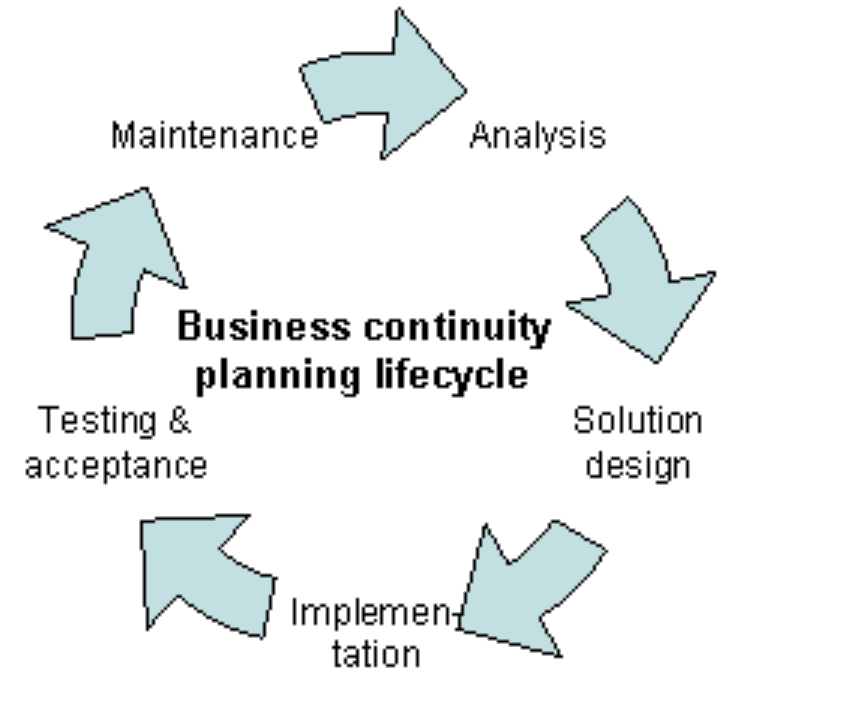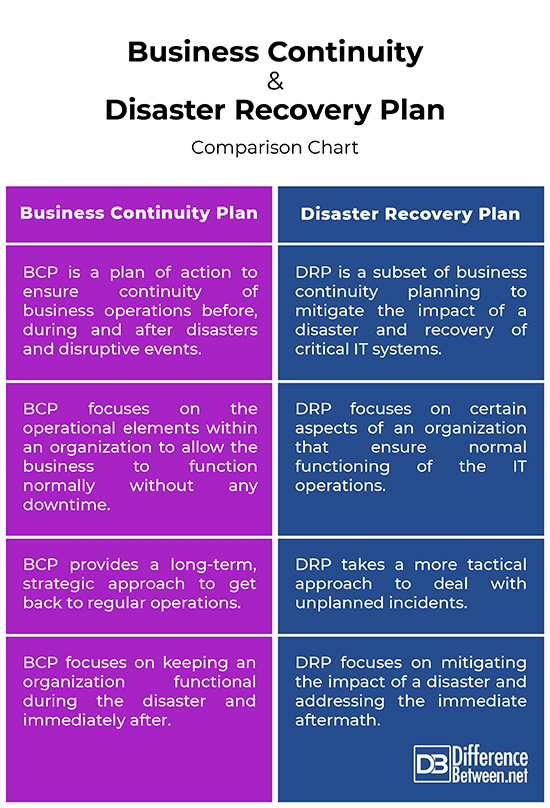Difference Between Business Continuity Plan and Disaster Recovery Plan
The world we live is not so perfect. We live in a world of uncertainties where we often see news about tsunamis, hurricanes, tornadoes, and other forces of nature creating havoc in their aftermath, destroying homes, devastating cities, and shutting down businesses. These natural disasters not only impact the normal lives of the normal people but also have devastating effects on businesses and organizations around the world. So, as a result, the need to plan for potential disruptions to business operations and technology services has increased exponentially. Businesses have contingencies in place that help prepare them for such events. Business continuity and disaster recovery are comprehensive plans of action that are put into effect when a disaster strikes. These are not prevention of the disaster itself, but prevention of what the organization is otherwise unprepared for.

What is Business Continuity Plan?
Business Continuity Plan (BCP), as the name suggests, is a long-term planning that involves creating and validating a plan that outlines how a business continue to operate during an unplanned disruption of services and operations. BCP is a proactive plan of creating a system of prevention and recovery in the face of a disaster, whether a flood, power failure, fire, or cyberattack. It is a plan of action to ensure continuity of business operations before, during and after disasters and disruptive events. BCP is concerned with the activities and processes required to ensure the continuation of critical business operations in an organization to avoid a total loss to the business. It concerns with managing the operational elements within an organization that allow the business to function normally in order to generate revenues. Standards are employed, protocols are established, and recovery systems are created that can lead to immediate mitigating steps.

What is Disaster Recovery Plan?
Disaster Recovery Plan (DRP) is the immediate plan of action that is followed by business continuity operations, and is concerned with the immediate impact of an unplanned event. DRP involves a set of protocols, procedures and policies set by an organization to deal with unplanned incidents such as power outages, natural calamities, and cyberattacks. It is a well-structured, documented approach to deal with specific IT-oriented disruptions such as server outage, power outage, cyberattack, system breach, and so on. Disaster recovery, as the name suggests, involves mitigating the effects of the disaster as quickly as possible and addressing the immediate aftermath. Whereas BCP provides a long-term, strategic approach to ensure continuity of operations, DRP is considered tactical which calls for immediate response to mitigating the impact of a disaster and recovery of critical IT systems. It is a part of business continuity planning and applied to certain aspects of an organization that ensure normal functioning of the IT operations.
Difference between Business Continuity Plan and Disaster Recovery Plan
Approach
– Business Continuity Plan (BCP) is a plan of action to ensure continuity of business operations before, during and after disasters and disruptive events. It provides a long-term, strategic approach to creating and validating a plan to ensure the continuation of critical business operations in an organization. Disaster Recovery Plan (DRP) is a plan of action that is immediately followed by business continuity operations to mitigate the impact of a disaster and recovery of critical IT systems. Unlike BCP, it takes a more tactical approach to deal with unplanned incidents.
Focus
– While disaster recovery is considered a subset of business continuity planning, the focus of the BCP and DRP are distinct, with the former attending to the business as a whole while the latter is more focused on information systems. There comes a time, when the two processes overlap. BCP focuses on the operational elements within an organization that allow the business to function normally whereas DRP focuses on certain aspects of an organization that ensure normal functioning of the IT operations. While these two plans have different scopes, they are fundamentally intertwined.
Steps
– Business continuity planning involves a series of procedures and steps to restore normal business operations within an organization when a disaster strikes, with maximum speed and minimal impact on operations. The steps involve risk assessment and management, establishing a planning committee, prioritizing recovery needs, obtaining top management commitment, developing and implementing a plan, testing the plan, test evaluation and the business continuity phase.
The primary purposes of DRP are prevention, continuity and recovery. The steps in DRP involve creating a disaster recovery plan, identifying and assessing disaster risks, identifying mitigating actions, determining Maximum Tolerable Downtime (MTD), criticality analysis, developing key recovery targets, telecommunication management and utility management, identifying recovery strategies, and finally getting the systems up and running.
Business Continuity and Disaster Recovery Plan: Comparison Chart

Summary
While both business continuity and disaster recovery planning are intertwined, their focus are distinct, with the former attending to the business as a whole while the latter is more focused on information systems. The business continuity plan involves multiple specific plans, including the disaster recovery plan. The scopes of both the plans are different, yet the disaster recovery plan is considered a subset of business continuity plan and BCP would be doomed to fail if it is not followed by a tactical plan of action for immediately dealing with disruption of information systems.
- Difference Between Caucus and Primary - June 18, 2024
- Difference Between PPO and POS - May 30, 2024
- Difference Between RFID and NFC - May 28, 2024
Search DifferenceBetween.net :
Leave a Response
References :
[0]Gregory, Peter. CISSP Guide to Security Essentials. Massachusetts, United States: Cengage Learning, 2015. Print
[1]Conrad, Erin et al. CISSP Study Guide. Massachusetts, United States: Syngress, 2012. Print.
[2]Snedaker, Susan. Business Continuity and Disaster Recovery Planning for IT Professionals. Oxford, United Kingdom: Butterworth-Heinemann, 2011. Print
[3]Doughty, Ken. Business Continuity Planning: Protecting Your Organization's Life. Florida, United States: CRC Press, 2000. Print
[4]Webber, Lawrence and Michael Wallace. The Disaster Recovery Handbook: A Step-by-Step Plan to Ensure Business Continuity and Protect Vital Operations, Facilities, and Assets. New York, United States: AMACOM, 2010. Print
[5]Image credit: https://commons.wikimedia.org/wiki/File:Schematic_ITSC_and_RTO,_RPO,_MI.jpg
[6]Image credit: https://en.wikipedia.org/wiki/File:BCPLifecycle.gif
